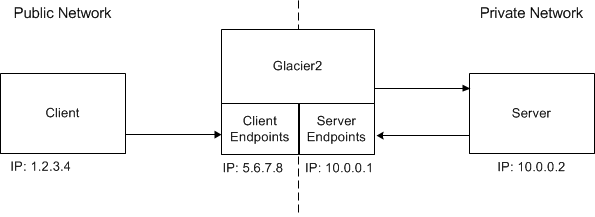How Glacier2 Works
The Ice core supports a generic router facility, represented by the Ice::Router interface, that allows a third-party service to "intercept" requests on a properly-configured proxy and deliver them to the intended server. Glacier2 is an implementation of this service, although other implementations are certainly possible.
Glacier2 normally runs on a host in the private network behind a port-forwarding firewall, but it can also operate on a host with access to both public and private networks. In this configuration it follows that Glacier2 must have endpoints on each network.
For the sake of example, the router's public address is 5.6.7.8 and its private address is 10.0.0.1.
In the client, proxies must be configured to use Glacier2 as a router. This configuration can be done statically for all proxies created by a communicator, or programmatically for a particular proxy. A proxy configured to use a router is called a routed proxy.
When a client invokes an operation on a routed proxy, the client connects to one of Glacier2's client endpoints and sends the request as if Glacier2 is the server. Glacier2 then establishes an outgoing connection to the client's intended server in the private network, forwards the request to that server, and returns the reply (if any) to the client. Glacier2 is essentially acting as a local client on behalf of the remote client.
If a server returns a proxy as the result of an operation, that proxy contains the server's endpoints in the private network, as usual. (Remember, the server is unaware of Glacier2's presence, and therefore assumes that the proxy is usable by the client that requested it.) In the absence of a router, a client would receive an exception if it attempted to use such a proxy. When configured with a router, however, the client ignores the proxy's endpoints and always sends requests to the router's client endpoints instead.
Glacier2's server endpoints, which reside in the private network, are only used when a server makes a callback to a client.
